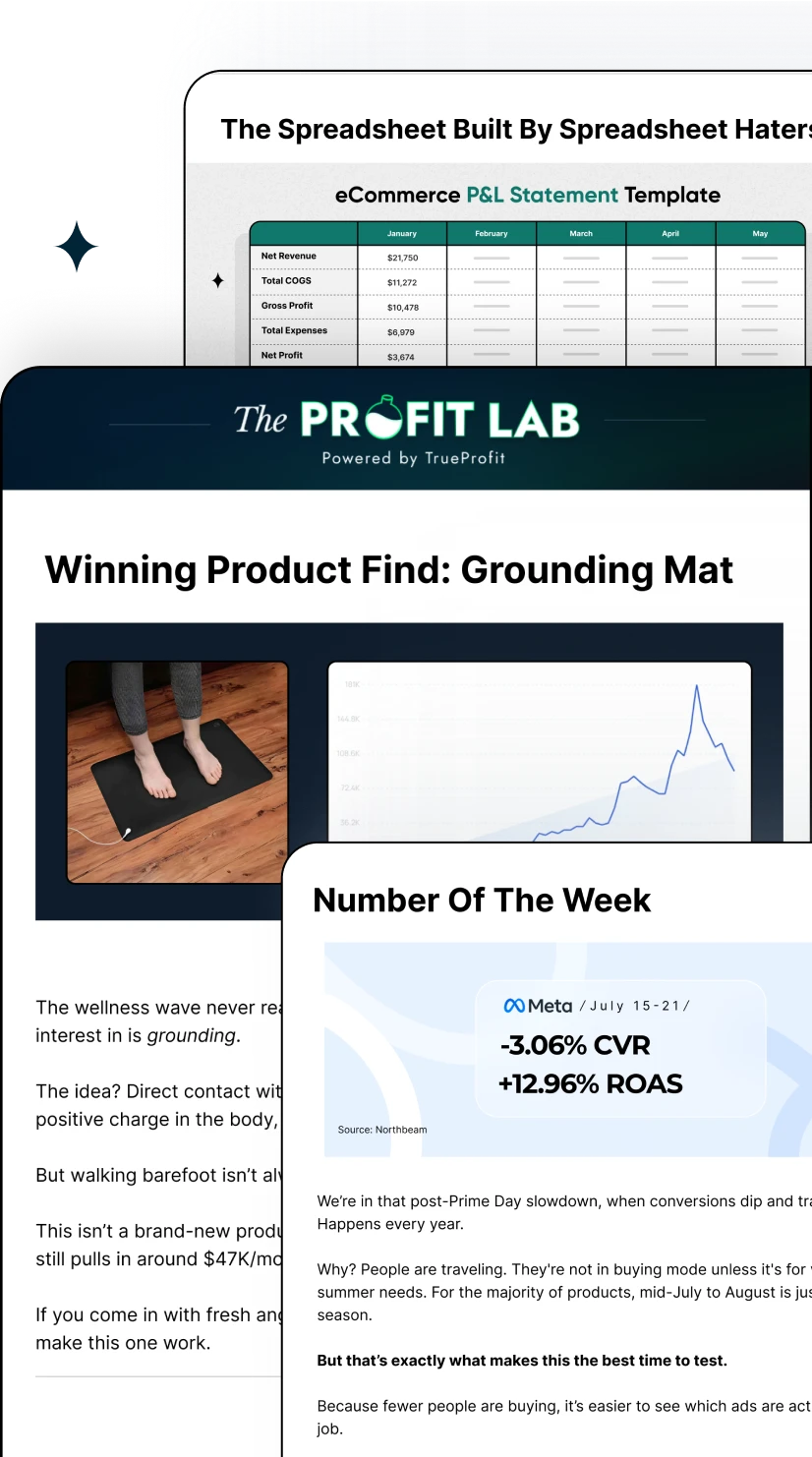Dropshipping Success Rate in 2025: Is It Really Low Risk?

Dropshipping is one of the most talked-about business models in eCommerce. It looks simple: find a product, list it on your store, run ads, and ship directly from the supplier to the customer. But behind the scenes, the reality is more complicated — and the success rate is much lower than the flashy gurus suggest.
In this article, we’ll dig into the real success rate of dropshipping, whether it’s profitable today, and what’s the risk you need to watch out for before starting.
What’s the Success Rate of Dropshipping in 2025?
First, let’s get on the same page about what “success” really means in dropshipping. For Harry Chu, Founder of TrueProfit, business success always comes down to net profit.
Even those flashy revenue screenshots or big sales days don’t mean much here. Only profit is the bottom line, the clearest signal that a store is truly succeeding.
Yet, Harry warns that this level of success is rare. Only about 1–5% of dropshippers ever build a profitable, sustainable business. Out of those, just 2–3% make over $500k profit per year.
After years of trying dropshipping himself, he explains why the success rate is so low: “Razor-thin profit margins are the main killer. Even stores generating $1.2–$1.5 million a year in revenue can struggle to break even once you account for ads, COGS, and other expenses.”, Harry Chu says.
It’s important to note that dropshipping also had its golden window during the coronavirus outbreak in 2020. With people stuck at home, local stores closed, and online shopping becoming the only option, eCommerce exploded almost overnight. Even low-quality stores could get sales. Many of today’s self-proclaimed “gurus” made their names riding that wave.
But once restrictions lifted and consumer behavior normalized, dropshipping went back to being what it’s always been — tough, competitive, and with very low success rates.
In short, dropshipping is far from the “easy-to-get-rich” path.
That said, success in this market is not impossible.
Is Dropshipping Still Profitable?
Despite the low success rate, dropshipping can still be profitable in 2025 and beyond. Here’s the proof: The global dropshipping market is projected to reach USD 1,253.79 billion by 2030, growing at a CAGR of 22% from 2025 to 2030, according to a new study by Grand View Research Inc.
That’s a clear sign there’s still money to be made—but not in the way gurus make it sound.
Here are some common myths spread by the ones who make money selling courses about dropshipping rather than doing dropshipping themselves:
1. Dropshippers Get Rich Fast
A lot of people start dropshipping thinking it’s a shortcut out of their 9-to-5 job. The promise of “set up a store today, quit your job tomorrow” is everywhere online. But here’s what reality usually looks like:


The truth is, the 1–5% of dropshippers who succeed aren’t lucky—they’re usually full-time operators with years of experience, strong supplier relationships, or advanced business models like high-ticket products or subscription programs. These elements take time to build; there’s no “instant success” button.
2. Anyone Can Get Rich With The China-Based Products
Harry Chu often emphasizes that the “AliExpress + Shopify + Facebook ads = $$$” formula that gurus sell rarely leads to real success. The reality of dropshipping is much tougher.
The problem? The same dropshipping products are already everywhere—Amazon, Temu, Walmart, Shein, even TikTok Shops. If a product is easy to find, competitors can copy you overnight. Customers usually go for the cheaper option or the faster shipping. That means your store margins are razor-thin and long-term profitability is extremely difficult.
In other words, relying solely on generic, China-based products is no shortcut to wealth. To actually succeed, you need an edge—unique products, exclusive suppliers, or a system that customers can’t easily replicate.
3. Dropshipping is the End-Goal Business
Let’s be real: no one should call dropshipping a “sustainable business.” If someone ever told you that, chances are they were trying to sell you something—courses, mentorships, or just hype. Dropshipping on its own isn’t a sustainable business model due to its heavy reliance on paid ads. With limited budgets, campaigns are constantly paused and restarted. This on-and-off cycle causes unpredictable traffic, and leaves stores struggling to maintain stable sales.
Ads are the main source of traffic, but with limited budgets, campaigns are constantly paused and restarted. This on-and-off cycle causes unpredictable traffic, and leaves stores struggling to maintain stable sales.
At TrueProfit, Harry Chu prefers to call dropshipping what it really is: a fulfillment method and a way to test products quickly. He explains, “You treat it as a stepping stone to a real brand, not the final business model. The end goal should be moving into private labeling, high-ticket niches, or brand-building. That’s where the long-term profit happens.”
4. Dropshipping Has $0 Upfront Cost
Technically, you can start dropshipping with no money, but the chances of building a profitable, professional store are super low. It’s extremely difficult without upfront capital.
Even the simplest dropshipping store requires some upfront investment. Most new sellers spend $5,000–$10,000 just to get their first store live — and the majority of that goes into ads and product testing.
The only “free” part in dropshipping is that you don’t pay for inventory before a customer buys it. (But in reality, this cost will come out later as your COGS when fulfilling the order). You’ll also need to factor in costs for a website, apps, subscriptions, transaction fees, shipping fees and sometimes even design or marketing help.
In short, dropshipping isn’t free, but it’s indeed cheaper and less risky than many other business models. If you can set aside $5,000–$10,000, you’ll give yourself a real shot at finding a winning product and building a profitable store.
What’s the Average Income of a Dropshipper?
There isn’t a fixed “average” income for dropshipping, because results vary widely depending on budget, strategy, and experience, and even a bit of luck.
For beginners, most reports start with $200–$1000 in upfront costs (mainly ads and product testing). After that, it’s common to see $2000–$10,000 in profit per month in the intermediate stages.
Experienced sellers, on the other hand, may average $10,000+ net profit per month. But they also invest heavily—sometimes $30,000+ in a single month on ads, supplier costs, and shipping fees.


This shows that your survival in dropshipping requires significant upfront costs and good cash flow management to handle low-margin months.
So if you’re starting out, the healthier mindset is not “How much can I make?” but “How much am I prepared to invest before things stabilize?” That shift in perspective helps you set realistic goals and increases your chances of lasting success.
5 Tips to Succeed in Dropshipping
Don't be worry if the dropshipping success rate is low. These healthy mindset and core tactics will put you in the top 1-5% successful dropshippers.
1. Treat Dropshipping as Testing, Not the End Game
We’ll say this: One of the biggest lessons is that dropshipping itself isn’t a sustainable business. Treat it as a fulfillment model plus a low-risk way to test products and see what customers respond to. But once you find a winning product, move quickly into private labeling or 3PL fulfillment. That’s how you control shipping times, improve margins, and build something competitors can’t easily copy.
2. Focus on Lifetime Value, Not One-Off Sales
Margins in dropshipping are razor-thin. If you only rely on one-time sales, your ad costs will eat you alive. The smarter play is to think about customer lifetime value (CLV). That means finding ways to bring customers back—subscriptions, product bundles, loyalty programs, or even upsells and cross-sells. This way, the goal is not to get profit at the first sale but accept the trade-off “We’ll lose 5–10% upfront, but make it back in 2–3 months.”
3. Automate Early to Save Your Sanity
Dropshipping has a lot of moving parts—orders, refunds, supplier communication, shipping delays, profit tracking. If you try to manage everything manually, you’ll burn out. Successful sellers invest in tools that automate essential processes, including order tracking, calculate profit after all expenses, and streamline fulfillment. The less time you spend buried in spreadsheets, the more time you can spend on growth activities like testing new products or improving your ads.
4. Build a Brand, Not Just a Store
Anyone can spin up a Shopify store and import products from AliExpress. That’s why most stores look the same—and why most fail. What sets you apart is branding. A real brand builds trust, tells a story, and gives customers a reason to buy from you instead of Amazon or Temu. Branding also makes your business less vulnerable to copycats. Without it, you’re just another faceless store selling the same product.
5. Stay Connected and Learn from Real Operators
One recurring theme from successful sellers: don’t go at it alone. Most “gurus” online sell dreams, not reality. The best advice comes from peers in the trenches—people running stores, sharing honest numbers, and trading strategies. That’s why joining Discord groups, eCommerce communities, or this ProfitLab masterminds newsletter is so valuable. You’ll learn what’s working right now, avoid costly mistakes, and find support during the tough months.
TrueProfit Exclusive Tip: Don’t Guess Your Margins
One of the biggest traps in dropshipping is thinking that revenue equals success. Stores can generate tens of thousands in sales, yet the real profit is razor-thin—or sometimes negative—after factoring in ads, COGS, shipping, transaction fees, and app subscriptions.
That’s why accurate profit tracking isn’t optional—it’s non-negotiable if you’re serious about making dropshipping successful.
This is where TrueProfit comes in.
It’s a tool designed specifically to track net profit, expenses, and revenue in real time, so you always know exactly how much you’re making—or losing—on each order. With TrueProfit, you can:
- Monitor real-time profits after all costs, including ad spend and shipping.
- Track fluctuating COGS to prevent margin erosion.
- Identify which products, ads, or fulfillment methods are actually profitable.
Dropshipping is risky but can still be profitable. A solid understanding of your profits and expenses is what will put you in the top 5% who succeed.
Final Thoughts
In the end, dropshipping is far from a get-rich-quick scheme. That said, success is not impossible. With the right strategy, careful cash flow management, and accurate profit tracking with tools like TrueProfit, dropshipping can be a solid stepping stone to your real dream e-commerce brand.
Think of it as a learning journey: you’ll test products, learn what works, and gradually move toward building a business with long-term growth. And remember, always learn how to track store metrics as you go as it will be the best lesson you can ever learn from this dropshipping journey.
Tracy is a senior content executive at TrueProfit – specializing in helping eCommerce businesses scale profitably through content. She has over 4 years of experience in eCommerce and digital marketing editorial writing. She develops high-impact content that helps thousands of Shopify merchants make data-driven, profit-focused decisions.




